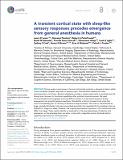A transient cortical state with sleep-like sensory responses precedes emergence from general anesthesia in humans
Author(s)
Lewis, Laura D; Piantoni, Giovanni; Peterfreund, Robert A; Eskandar, Emad N; Harrell, Priscilla Grace; Akeju, Oluwaseun; Aglio, Linda S; Cash, Sydney S; Mukamel, Eran A; Purdon, Patrick L; Brown, Emery Neal; ... Show more Show less
Downloadelife-33250-v1.pdf (3.405Mb)
PUBLISHER_CC
Publisher with Creative Commons License
Creative Commons Attribution
Terms of use
Metadata
Show full item recordAbstract
During awake consciousness, the brain intrinsically maintains a dynamical state in which it can coordinate complex responses to sensory input. How the brain reaches this state spontaneously is not known. General anesthesia provides a unique opportunity to examine how the human brain recovers its functional capabilities after profound unconsciousness. We used intracranial electrocorticography and scalp EEG in humans to track neural dynamics during emergence from propofol general anesthesia. We identify a distinct transient brain state that occurs immediately prior to recovery of behavioral responsiveness. This state is characterized by large, spatially distributed, slow sensory-evoked potentials that resemble the K-complexes that are hallmarks of stage two sleep. However, the ongoing spontaneous dynamics in this transitional state differ from sleep. These results identify an asymmetry in the neurophysiology of induction and emergence, as the emerging brain can enter a state with a sleep-like sensory blockade before regaining responsivity to arousing stimuli.
Date issued
2018-08Department
Institute for Medical Engineering and Science; Massachusetts Institute of Technology. Department of Brain and Cognitive SciencesJournal
eLife
Publisher
eLife Sciences Publications, Ltd.
Citation
Lewis, Laura D, Giovanni Piantoni, Robert A Peterfreund, Emad N Eskandar, Priscilla Grace Harrell, Oluwaseun Akeju, Linda S Aglio, et al. “A Transient Cortical State with Sleep-Like Sensory Responses Precedes Emergence from General Anesthesia in Humans.” eLife 7 (August 10, 2018). © Lewis et al.
Version: Final published version
ISSN
2050-084X